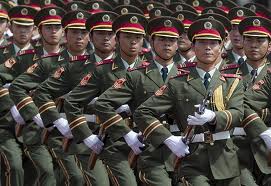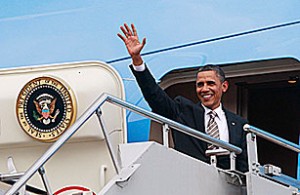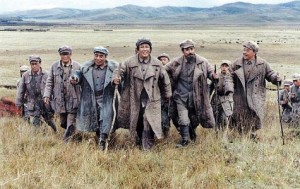May 2, 2011
Don’t Bet Your Bottom Dollar
By TOM ENGLEHARDT
 Tired of Afghanistan and all those messy, oil-ish wars in the Greater Middle East that just don’t seem to pan out? Count on one thing: part of the U.S. military feels just the way you do, especially a largely sidelined Navy — and that’s undoubtedly one of the reasons why, a few months back, the specter of China as this country’s future enemy once again reared its ugly head.
Tired of Afghanistan and all those messy, oil-ish wars in the Greater Middle East that just don’t seem to pan out? Count on one thing: part of the U.S. military feels just the way you do, especially a largely sidelined Navy — and that’s undoubtedly one of the reasons why, a few months back, the specter of China as this country’s future enemy once again reared its ugly head.
Back before 9/11, China was, of course, the favored future uber-enemy of Secretary of Defense Donald Rumsfeld and all those neocons who signed onto the Project for the New American Century and later staffed George W. Bush’s administration. After all, if you wanted to build a military beyond compare to enforce a long-term Pax Americana on the planet, you needed a nightmare enemy large enough to justify all the advanced weapons systems in which you planned to invest.
As late as June 2005, neocon journalist Robert Kaplan was still writing in the Atlantic about “How We Would Fight China,” an article with this provocative subhead: “The Middle East is just a blip. The American military contest with China in the Pacific will define the twenty-first century. And China will be a more formidable adversary than Russia ever was.” As everyone knows, however, that “blip” proved far too much for the Bush administration.
Finding itself hopelessly bogged down in two ground wars with rag-tag insurgency movements on either end of the Greater Middle Eastern “mainland,” it let China-as-Monster-Enemy slip beneath the waves. In the process, the Navy and, to some extent, the Air Force became adjunct services to the Army (and the Marines). In Iraq and Afghanistan, for instance, U.S. Navy personnel far from any body of water found themselves driving trucks and staffing prisons.
It was the worst of times for the admirals, and probably not so great for the flyboys either, particularly after Secretary of Defense Robert Gates began pushing pilotless drones as the true force of the future. Naturally, a no-dogfight world in which the U.S. military eternally engages enemies without significant air forces is a problematic basis for proposing future Air Force budgets.
There’s no reason to be surprised then that, as the war in Iraq began to wind down in 2009-2010, the “Chinese naval threat” began to quietly reemerge. China was, after all, immensely economically successful and beginning to flex its muscles in local territorial waters. The alarms sounded by military types or pundits associated with them grew stronger in the early months of 2011 (as did news of weapons systems being developed to deal with future Chinese air and sea power). “Beware America, time is running out!” warned retired Air Force lieutenant general and Fox News contributor Thomas G. McInerney while describing China’s first experimental stealth jet fighter.
Others focused on China’s “string of pearls”: a potential set of military bases in the Indian Ocean that might someday (particularly if you have a vivid imagination) give that country control of the oil lanes. Meanwhile, Kaplan, whose book about rivalries in that ocean came out in 2010, was back in the saddle, warning: “Now the United States faces a new challenge and potential threat from a rising China which seeks eventually to push the U.S. military’s area of operations back to Hawaii and exercise hegemony over the world’s most rapidly growing economies.” (Head of the U.S. Pacific Command Admiral Robert Willard claimed that China had actually taken things down a notch at sea in the early months of 2011 — but only thanks to American strength.)
Behind the overheated warnings lay a deeper (if often unstated) calculation, shared by far more than budget-anxious military types and those who wrote about them: that the U.S. was heading toward the status of late, great superpower and that, one of these years not so far down the line, China would challenge us for the number one spot on the seas — and on the planet.
The Usefulness of a Major Enemy
You know the background here: the victor in the Cold War, the self-proclaimed “sole superpower” ready to accept no other nation or bloc of nations that might challenge it (ever), the towering land that was to be the Roman Empire, the British Empire, and the Vulcans rolled into one. Well, those dreams are already in history’s dustbin. If opinion polls are to be believed, a gloomy American populace now senses that the sun has set on American fantasies of ultimate dominance with what seems like record speed. These days, the U.S. appears capable of doing little with its still staggering military might but fight Pashtun guerillas to a draw in distant Afghanistan and throw its air power and missile-armed drones at another fifth-rate power in a “humanitarian” gesture with the usual destruction and predictable non-results.
Toss in the obvious — rotting infrastructure, fiscal gridlock in Washington, high unemployment, cutbacks in crucial local services, and a general mood of paralysis, depression, and confusion — and even if the Chinese are only refurbishing a mothballed 1992 Ukrainian aircraft carrier as their first move into the imperial big time, is it really so illogical to imagine them as the next “sole superpower” on planet Earth?
After all, China passed Japan in 2010 as the globe’s number two economy, the same year it officially leaped over the United States to become the world’s number one emitter of greenhouse gases. Its growth rate came in at something close to 10% right through the great financial meltdown of 2008, making it the world’s fastest expanding major economy. By mid-2010, it had 477,000 millionaires and 64 billionaires (second only to the U.S.), and what’s always being touted as a burgeoning middle class with an urge for the better things. It also had the world’s largest car market (the U.S. came in second), and the staggering traffic jams to prove it, not to speak of a willingness to start threatening neighbors over control of the seas. In short, all the signs of classic future imperial success.
And those around the U.S. military aren’t alone in sounding the alarm. Just last week, the International Monetary Fund (IMF) quietly posted a report at its website indicating that by 2016, the “age of America” would be over and, by one measure at least, the Chinese economy would take over first place from the American one.
With growing fears in the military-industrial complex of future cuts in the Pentagon budget (even though, as of now, it’s still rising), there will undoubtedly be increased jockeying among the armed services for slices of the military pie. This means an increasing need for the sort of enemies and looming challenges that would justify the weapons systems and force levels each service so desperately wants.
And there’s nothing like having a rising power of impressive proportions sink some money into its military (even if the sums are still embarrassingly small compared to the United States). In the Chinese case, it also helps when that country uses its control over rare earth metals to threaten Japan in a dispute over territorial waters in the East China Sea, begins to muscle neighbors on the high seas, and — so rumor has it — is preparing to name its refurbished aircraft carrier, which might be launched this summer, after the Qing Dynasty admiral who conquered the island of Taiwan.
The Unpredictability of China
Still, for all those naval and air power types who would like to remove American power from a quicksand planet and put it offshore, for those who would like to return to an age of superpower enmity, in fact, for all those pundits and analysts of whatever stripe picking China as the globe’s next superstar or super evildoer, I have a small suggestion: take a deep breath. Then take this under advisement: we’ve already been through a version of this once. Might it not be worth approaching that number-one prediction with more humility the second time around?
As a start, let’s take a stroll down memory lane. Back in 1979, Ezra Vogel, Harvard professor and Asian specialist, put out a book that was distinctly ahead of its time in capturing the rise to wealth and glory of a new global power. He entitled it Japan as Number One: Lessons for America, and in praising the ways Japanese industry operated and the resulting “Japanese miracle,” the title lacked only an exclamation point. Vogel certainly caught the temper of the times, and his scholarly analysis was followed, in the 1980s, by a flood of ever more shrill articles and books predicting (in fascination or horror) that this would indeed someday be a Japanese world.
The only problem, as we now know: ’tweren’t so. The Japanese economic bubble burst around 1990 and a “lost decade” followed, which never quite ended. Then, of course, there was the 2011 earthquake-cum-tsunami-cum-nuclear-disaster that further crippled the country.
So how about China as Number One: Lessons for America? After all, its economy is threatening to leave Japan in the dust; if you were one of its neighbors, you might indeed be fretting about your offshore claims to the mineral wealth under various local seas; and everyone knows that Shanghai is now Blade Runner without the noir, just 40-story towers as far as the eye can see. So what could go wrong?
As a specialty line, our intelligence services offer new administrations predictions on the world to come by projecting present trends relatively seamlessly into a reasonably similar future. And why shouldn’t that be a logical way to proceed? So if you project Chinese growth rates into the future, as the IMF has just done, you end up with a monster of success (and assumedly a military with a global reach). It’s not that hard, in other words, to end up with the U.S. Navy’s nightmare enemy.
But so much on our present planet suggests that we’re not in a world of steady, evolutionary development but of “punctuated equilibrium,” of sudden leaps and discontinuous change. Imagine then another perfectly logical scenario: What if, like Japan, China hits some major speed bumps on the highway to number one?
As you think about that, keep something else in mind. China’s story over the last century-plus already represents one of the great discontinuous bursts of energy of our modern moment. To predict most of the twists and turns along the way would have been next to impossible. In 1972, in the wake of the Cultural Revolution that Mao Zedong had set in motion six years earlier, to take but one example, no intelligence service, no set of seers, no American would have predicted today’s China or, for that matter, a three-and-a-half-decade burst of Communist Party-controlled capitalist industrial expansionism. The pundit who offered such a prediction then would have been drummed out of the corps of analysts.
No one at the time could have imagined that the giant, independent but impoverished communist land would become the expansive number two capitalist economy of today. In fact, from the turn of the previous century when China was the basket case of Asia and a combined Japanese/Western force marched on Beijing, when various great powers took parts of the country as their own property or “concessions,” followed by ensuing waves of warlordism, nationalism, revolutionary ferment, war with Japan, civil war, and finally the triumph of a communist regime that united the country, the essence of China’s story has been unpredictability.
So what confidence should we now have in projections about China that assume more of the same, especially since, looking toward the future, that country seems like something of a one-trick pony? After all, the ruling Communist Party threw the dice definitively for state capitalism and untrammeled growth decades ago and now sits atop a potential volcano. As the country’s leaders undoubtedly know, only one thing may keep the present system safely in place: ever more growth.
The minute China’s economy falters, the minute some bubble bursts, whether through an overheating economy or for other reasons, the country’s rulers have a problem on their hands that could potentially make the Arab Spring look mild by comparison. What many here call its growing “middle class” remains anything but — and there are literally hundreds of millions of forgotten peasants and migrant workers who have found the Chinese success story less than a joy.
A Revolutionary Tradition for the Ages
It might take only a significant economic downturn, a period that offered little promise to Chinese workers and consumers, to unsettle that country in major ways. After all, despite its striking growth rates, it remains in some fashion a poor land. And one more factor should be taken into consideration that few of our seers ever consider. It’s no exaggeration to say that China has a revolutionary tradition unlike that of any other nation or even region on the planet.
Since at least the time of the Yellow Turban Rebellion in 184 CE, led by three brothers associated with a Taoist sect, the country has repeatedly experienced millenarian peasant movements bursting out of its interior with ferocious energy. There is no other record like it. The last of these was undoubtedly Mao Zedong’s communist revolution.
Others would certainly include the peasant uprising at the end of the Ming Dynasty in the seventeenth century and, around the time of the American Civil War, the Taiping Rebellion. It was led by a man we would today call a cultist who had created a syncretic mix of Chinese religions and Christianity (and who considered himself the younger brother of Jesus Christ). Before Qing Dynasty forces finally suppressed it and a series of other rebellions, an estimated 20 million people died.
When Chinese leaders banned and then tried to stamp out the fast-spreading Falun Gong movement, they were not — as reported here — simply “repressing religion”; they were suppressing what they undoubtedly feared could be the next Taiping Rebellion. Even if few intelligence analysts in the West are thinking about any of this, rest assured that the Communist rulers of China know their own history. That’s one reason why they have been so quick to crack down on any Arab-Spring-like demonstrations.
In addition, though I’m no economist, when I look around this planet I continue to wonder (as the Chinese must) about the limits of growth for all of us, but certainly for a vast country desperate for energy and other raw materials, with an aging population, and an environment already heavily polluted by the last 40 years of unchecked industrial expansion. There is no question that China has invested in its military, put together a powerful (if largely defensive) navy, elbowed its neighbors on questions of control of undersea mineral rights, and gone on a global search to lock up future energy resources and key raw materials.
Nonetheless, if predictions were to be made and trends projected into the future, it might be far more reasonable to predict a cautious Chinese government, focused on keeping its populace under control and solving confounding domestic problems than an expansively imperial one. It’s almost inconceivable that, in the future, China could or would ever play the role the U.S. played in 1945 as the British Empire went down. It’s hard even to imagine China as another Soviet Union in a great global struggle with the United States.
And speaking of the conjunctures of history, here’s another thought for the U.S. Navy: What if this isn’t an imperial planet any more? What if, from resource scarcity to global warming, humanity is nudging up against previously unimagined limits on unbridled growth? From at least the seventeenth century on, successive great powers have struggled over the control of vast realms of a globe in which expansion seemed eternally the name of the game. For centuries, one or more great powers were always on hand when the previous great imperial power or set of powers faltered.
In the wake of World War II, with the collapse of the Japanese and German empires, only two powers worthy of the name were left, each so mighty that together they would be called “superpowers.” After 1991, only one remained, so seemingly powerful that it was sometimes termed a “hyperpower” and many believed it had inherited the Earth.
What if, in fact, the U.S. was indeed the last empire? What if a world of rivalries, on a planet heading into resource scarcity, turned out to be less than imperial in nature? Or what if — and think of me as a devil’s advocate here — this turned out not to be an imperial world of bitter rivalries at all, but in the face of unexpectedly tough times, a partnership planet?
Unlikely? Sure, but who knows? That’s the great charm of the future. In any case, just to be safe, you might not want to start preparing for the Chinese century quite so fast or bet your bottom dollar on China as number one. Not just yet anyway.
Tom Engelhardt, co-founder of the American Empire Project, runs the Nation Institute’s TomDispatch.com, where this article originally appeared. His latest book is The American Way of War: How Bush’s Wars Became Obama’s (Haymarket Books).
___________________________________________
To breathe the true air of freedom and democracy you need independent media lungs. Staffed with journalists and political observers not beholden to the status quo.
SUPPORT THE GREANVILLE POST AND CYRANOS JOURNAL TODAY.
[donation-can goal_id=’support-tgp-before-were-gone’ show_progress=true show_description=true show_donations=false show_title=true title=”]
____________________________________________
Make creeps like Kissinger and Palin miserable.

Read The Greanville Post by RSS Syndication (updates delivered every 4 days to your emailbox) and fortify your ability to fight back! Just click anywhere on Lady Liberty below and enter your email address.

|
 The significance of President Barack Obama’s “shift” toward the Asia Pacific region has become evident in the course of the past week. On every front—diplomatic, economic and military—the Obama administration is aggressively confronting China, greatly heightening tensions within the region and every country of the region.
The significance of President Barack Obama’s “shift” toward the Asia Pacific region has become evident in the course of the past week. On every front—diplomatic, economic and military—the Obama administration is aggressively confronting China, greatly heightening tensions within the region and every country of the region.




